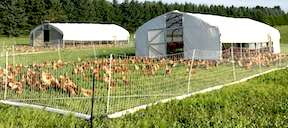
With 2,800 laying hens on pasture, Michael Gutschenritter had better things to do with his time than moving electric fence. His HenPen sliding fence saves time and energy. Best of all, it leaves more time to spend with his growing family and for other work on the family’s Three Brothers Farm. In addition to selling eggs direct to consumers and through a network of local stores, he and his wife market lamb and wool produced on their 100-acre farm.
“I built the first one when our first daughter was born 4 years ago,” says Gutschenritter. “It worked so well that I added three more.”
Cost savings were immediately apparent. Gutschenritter realized he needed only a third as much electric netting. Time savings were apparent as well. He can move the entire 3,000-sq. ft. unit in less than 5 mins. Just hook on a tractor and go versus spending about 75 mins. per day moving fences by hand. Installing a guy wire at corners with each move is the only manual labor needed.
Gutschenritter uses the 20 by 40-ft. Prairie Schooner from Featherman Equipment (Vol. 42, No. 4) for a mobile coop. Hens have an additional 2,200 sq. ft. within the enclosed sliding yard, with fences extending 10 ft. to either side of the coop.
“The design would work equally well with any large, skid-style coop, such as the Mobile Range Coop or a do-it-yourself coop,” says Gutschenritter. “We use it with laying hens, but it has been used with all types of poultry, including broilers and turkeys.”
Gutschenritter received funding to refine and evaluate his original concept from the Northcentral Region of Sustainable Agriculture Research and Education (SARE), a USDA program. He shared details of how he built his prototype HenPen unit in a SARE project overview (FNC21-1275).
He began by reinforcing the coop and building a framework that extended to either side, as well as front and back. The frame included 8-ft. landscape timbers mounted perpendicular to the coop. He attached 4-in. HDPE pipe to the ends of the timbers to create sides for the frame. Chain link fence top rails were used as braces from the coop to the pipes to help maintain the shape of the frame when the coop moved.
Gutschenritter removed the posts from the netting to be used and trimmed the spikes to 3 1/2 in. He laid the electric netting (without posts) along each side of the frame. He drilled holes for posts in the frame at pipe connectors and at corners for corner posts. He inserted the posts and wove them back into the netting.
The final step was to connect a rope from the front corners of the coop to the front corners of the fence frame. As the HenPen is pulled forward, the rope prevents the frame from collapsing.
Gutschenritter notes that the addition of the fence frame to the coop increased the horsepower needed to move the coop. Where he had been using a 30-hp. tractor, he upgraded to 75 hp. “I was ripping up the pasture with the lightweight tractor trying to move the coops,” he says.
In the 4 years since he designed his first HenPen, he made several changes to the design. They include improving the corners and using higher-quality materials for the frame.
“The changes allow the entire fence to swerve as needed while being dragged,” says Gutschenritter. “The new corners and higher quality materials have allowed me to reduce the amount of bracing and wood mounts. This led to easier construction and slightly lower costs, as well as a higher value system.”
Gutschenritter has hosted tours of his system, as well as shared the project at several farmer meetings. He also developed a 29-page construction manual with extensive pictures and step-by-step instructions. It’s priced at $300 and includes regular email updates on use and design.
Some of the changes made over time include replacing the rope brace with a 14-ft. pipe running from the front of the pen to the coop. “It provides more rigidity and makes it easier to move the pen through tall grass and over woodier stems like burdock without kinking,” says Gutschenritter. “I also designed a water system to work with the HenPen, all accessible from outside. Changes like these will continue to be made and shared with the folks who buy the manual.”
Contact: FARM SHOW Followup, Three Brothers Farm, 34109 Mapleton Rd., Oconomowoc, Wis. 53066 (ph 262-470-4429; 3brothersfarm@gmail.com; www.3brothersfarmwi.com).
